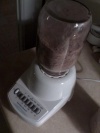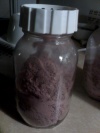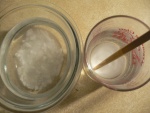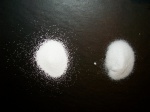 |
Note: | This page tracks the development of Amor fati's Compendium for the Extraction of Jurema.[1] The content is to remain accurate as such. |
The extraction of DMT and its analogous mixtures, deemed spice, has long been a cornerstone of modern psychonautical and entheogenic practice. In particular, extraction from the high-yielding, low fat root bark of Mimosa tenuiflora--or MHRB, otherwise known as Jurema--has played a most pivotal role in providing an abundant and reliable source to further the development of various means of rendering and administering spice. Though the bulk of the history regarding this development has unfortunately hinged on the use of hazardous or otherwise unwholesome chemicals common to the production of less savory substances, recent years prior to the authorship of this tek have seen a boom in less toxic, nontoxic and even food grade methods of extraction among other faculties of refinery--many with an astounding capacity for efficiency.
It is the goal of this tek not to simply shed the use of toxic chemicals; rather, the tek seeks to comprehensively illustrate a modern and efficient means of extraction that doesn't require one to go too far out of one's way or bog down one's extraction experience unnecessarily by requiring a hodgepodge of questionable chemicals for which the operator may not ever have any real use for in one's household. If one considers the possibilities of entering the world of entheogenic extraction with a fresh mindset, devoid of the expectation that hazardous chemicals are necessary to that process, the prospect of using such chemicals would hardly be an attractive one and more ready-at-hand materials may be considered.
In this tek, we will explore the implementation of Limtek as alternative to traditionally high volume water-intensive A/B teks that notoriously require at least a hazardous base like lye. Then we will consider the use of various alternative solvents, typically comprising oils like limonene or various types of vegetable oil, as alternatives to odorous and hazardous petroleum based solvents. Finally, we will explore various means of obtaining a administrable extract, whether by salting with food grade acids, or by going a step further to obtain freebase--a process hinging on various manner of implementing of sodium carbonate. More toxic materials like IPA or Heptane may come into play, depending on the route chosen, but one may find even those staples of the extraction community unnecessary with a bit of skillful application.
|
|
| Materials Required |
 |
Source Material:
|
Solvents:
|
Reagents/Desiccants:
|
Equipment:
- 2 regular-mouth quart mason jars
- 1 32oz HDPE bottle
- Cheese cloth
- Suggested Equipment:
- Crockpot
- Food dehydrator
- Separatory device and/or freezer
- Evaporation dish
- Small container for preparing FASW
- Larger HDPE or glass jug for salting
|
|
|
|
 |
Materials Preparation
THP:
- Prepare a funnel from a 32oz HDPE bottle by cutting off the bottom.
- Any sort of cotton can be used so long as it seals the opening from particulates and isn't so tight as to hinder the passage of liquids.
- Cut a strip of cheesecloth, and roll it up loose enough to fit in the neck of the bottle and provide a filter.
Pulverization:
- Prepare MHRB for pulverization by breaking up by hand or any other method suitable.
- Add 100g MHRB to a regular-mouth quart mason jar.
- Attach blender blade assembly and pulverize contents thoroughly.
| NOTE |
 |
| The process of pulverization is of course meant for cases in which shredded or whole MHRB is in use; however, the same method may be applied for mixing the contents for extraction.
|
|
 1-2: MHRB moistened with vinegar.  3.1: The moistened mixture.  3: Thorough lime/MHRB mixture, still in need of H2O. A/B Reaction:
- Thoroughly moisten pulverized or powdered MHRB with vinegar by stirring or blending in a mason jar.
- Heat the contents by partially submerging the jar in a hot water bath while stirring frequently for aprx. an hour.
- Continue heating and add lime and water, stirring continuously to ensure an even mixture, adding only enough water to render a doughy mixture.
NPS Flush:
- Add enough NPS of choice to contents of jar so that the mixture is completely submerged, and continue to heat and stir to satisfaction.
- Decant NPS into THP to filter and collect in a clean and empty mason jar.
Salting:
- Combine NPS with an amount of aprx. 200mL FASW containing at least. 1g fumaric acid in a jug and shake vigorously.
- Allow to settle and collect the polar layer for evaporation, recycling NPS for re-use.
- Repeat NPS wash and salting process at least twice before pouring the entire content of the jar into THP, allowing residual solvent to drain for collection.
Separatory Methods
- For most purposes, freezing the nonpolar/polar mixture after a thorough, vigorous salting will bring about a complete separation without the trouble of breaking emulsions.
- Freezing will also enable the nonpolar layer to be decanted from the frozen polar layer, which can then be rinse with a more viscous nonpolar or less polar solvent like limonene or IPA (separately or together in sequence) to help remove residual oil.
- Gelling may occur with vegetable oil, in which case shaking and/or squeezing the salting container may be employed to remove the gel from the frozen solid polar layer.
- If residual oil remains, a separatory device may aid in preventing any from contaminating the end product, though contamination may be removed from the solid salted product at such a stage if necessary.
- Alternatively, a separatory funnel, culinary separator, or pipette may be employed in conjunction with emulsion breaking techniques.
|
|
|
|
 |
Materials Preparation:
Fumarate Wash:
Freebase Conversion:
|
Appendices
- ↑ Tek Proposal[1]








